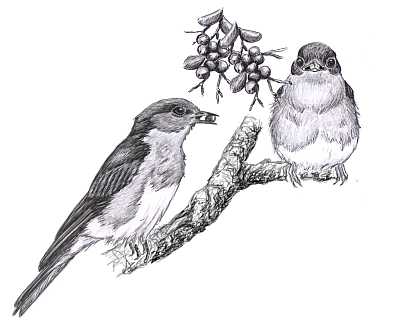
Dear Bird Folks:
Last week I was shocked to see a flock of bluebirds in my backyard. Is this unusual and how can I keep them?
– Karla, Yarmouthport
No way Karla,
You cannot keep those bluebirds. You must learn to share them with the rest of us. Last year the Cape Cod Commission passed the tough Bluebird Hogging Act of 2002, which clearly states that anyone who has a flock of bluebirds must send them immediately to my yard within twenty-four hours or be subject to cold envious stares for the next 100 years. Sorry Karla, the law is the law.
The return of the Eastern Bluebird is one of the most welcomed success stories in nature. Twenty years ago bluebirds were rare on Cape Cod and the population was dropping. Better controls of pesticides, along with the spread of nest boxes, has not only halted the decline but has started a remarkable increase in bluebird populations.
In the warmer months bluebirds form territories, travel in pairs and are more often found in open areas like parks, fields or farmland. In the summer they hunt by sitting high on a perch, where they use their excellent eyesight to spot crickets or caterpillars. I know you didn’t ask about what bluebirds ate in the summer, but my job is to make you a complete person. You’ll thank me for this someday.
After the nesting season bluebirds often stay together as a family group, moving around in search of food. Sometimes several family groups join together and form a larger flock of twenty or more birds. Bluebird migration habits are somewhat inconsistent. Some birds head south to avoid the cold, while others, even up north, remain in the area in which they were hatched and try to survive the winter. Good luck to them.
When it comes to wintering bluebirds on Cape Cod, it is unclear, at least to me, if we have only locally raised family groups moving around the Cape or if we have flocks of birds from other parts of New England. Like the robins that have come from all over, I’d be willing to bet that we also get bluebirds that travel here to enjoy our balmy winters. (The Chamber of Commerce asked me to add that balmy part.)
During the winter time bluebirds give up their love for insects and look for fruit and berries. These berries include bayberries and red cedar, which we are lucky enough to have around here. The cedar trees also offer good roosting habitat for bluebirds.
And yes, there are a few things we can do to encourage bluebirds to visit our yards. Water is a good place to start. We get lots of reports from people who are getting bluebirds coming to their unfrozen birdbaths. Also, the birdhouses that birds use for nesting in during the summer are often used as roosting boxes in the winter. Don’t be in a hurry to take your boxes down in the fall or late putting out new ones that you may be making in your basement. An entire flock of bluebirds has been found huddling in a single nestbox during cold weather.
Bluebirds have also been known to come to trays of currants, raisins and chopped suet. There are also a few custom suet mixes that some people make that seem to attract bluebirds. But since I’m not into recipe swapping, you won’t be learning them from me.
Finally, it is a real good idea to plant some berry producing trees and bushes. Here is a pop quiz: What are the two plants that I’ve already mentioned that bluebirds like? Well? If you guessed red cedars and bayberries you would be right. Other good guesses would be Virginia creeper, mountain ash, mulberry and viburnum. However, if you guessed African violets and creamed corn you would be wrong, and scary.